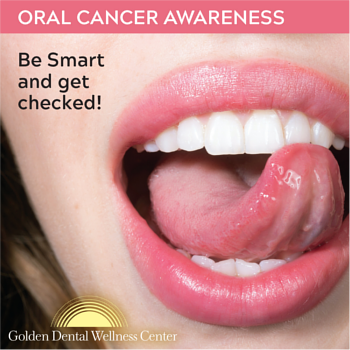Alternative Therapies
Oral Cancer Screening

Oral cancer screening is a routine part of a dental examination. Regular check-ups, utalizing including an examination of the entire mouth, are essential in the early detection of cancerous and pre-cancerous conditions. You may have a very small, but dangerous, oral spot or sore and not be aware of it.
The doctor will carefully examine the inside of your mouth and tongue and in some patients may notice a flat, painless, white or red spot or a small sore. Although most of these are harmless, some are not. Harmful oral spots or sores often look identical to those that are harmless, but testing can tell them apart. If you have a sore with a likely cause, the doctor may treat it and ask you to return for re-examination.
To ensure that a spot or sore is not dangerous, the doctor may choose to perform a simple test, such as a brush test. A brush test collects cells from a suspicious lesion in the mouth. The cells are sent to a laboratory for analysis. If precancerous cells are found, the lesion can be surgically removed if necessary during a separate procedure. It's important to know that all atypical and positive results from a brush test, or other screening tests, must be confirmed by biopsy.
OralCDx

The OralCDx Brush Test is a painless method of testing "everyday" tiny oral spots.
During a careful professional examination most people will be found to have one or more tiny white or red spots in their mouth at one time or another. These tiny spots do not usually contain any unhealthy cells, but only laboratory testing, like the Brush Test, can tell.
The brush is used to quickly collect a sample for computer-assisted laboratory analysis.
If one of your oral spots is found by the OralCDx lab to contain unhealthy cells, it can then typically be removed - years before it can cause any harm.
Ask us about OralCDx testing today!
Waterlase
The Waterlase MD is a revolutionary dental device that uses a combination of laser energy and water to perform many traditional dental procedures without anesthesia or pain. The Waterlase MD, uses a less invasive approach that conserves healthy tooth structure, which helps teeth function better and last longer..png)
When the traditional dental drill is used, heat and vibration are the major causes of most of the pain. The Waterlase MD works so fast and avoids both heat and vibration, so the tooth nerve can't respond to register pain. This means no shots or the numb feeling after the dental visit.
The Waterlase MD can also perform many soft tissue or gum procedures with little or no discomfort or bleeding.
Platelet Rich Fibrin

Platelet rich fibrin (PRF), a by-product of blood (plasma), is rich in platelets. PRF permits the body to take advantage of the normal healing pathways at a greatly accelerated rate. During the healing process, the body rushes many cells and cell-types to the wound in order to initiate the healing process. One of those cell types is platelets. Platelets perform many functions, including formation of a blood clot and release of growth factors into the wound. These growth factors function is to assist the body in repairing itself by stimulating stem cells to regenerate new tissue. The more growth factors released into the wound, the faster the healing.
PRF promotes healing in bone grafting for dental implants, onlay and inlay grafts, sinus lift procedures, ridge augmentation procedures, and closure of cleft, lip, palate defects, repair of bone defects creating by removal of teeth or small cysts, and the repair of fistulas between the sinus cavity and mouth. This is of great significance to the surgeon who places dental implants. By adding PRF your implant surgeon can now grow bone more predictably and faster than ever before.
Advantages of PRF
- PRF is a by-product of the patient's own blood; therefore, disease transmission is not an issue because bovine, cadaver, or synthetic bone is not used.
- PRF can be generated in the convenience of your doctor's office as a outpatient surgical procedure.
- PRF promotes faster tissue regeneration.
Frequently Asked Questions PRF:
Q: Is PRF safe?
A: Yes. During the outpatient surgical procedure a small amount of your own blood is drawn out via the IV. This blood is then placed in the PRF centrifuge machine and spun down. In less than 15 minutes, the PRF is formed and ready to use.
Q: Is PRF be used in all bone grafting cases?
A: Not necessarily, however, as with most cases the application of PRF to a graft will increase the final amount of bone present in addition to making the wound heal faster and more efficiently.
Q: How much does it cost?
A: The cost of a PRF application is approximately $600. Unfortunately most insurance plans do not cover PRF and the expense is paid by the patient.
Calcium Method of Osteo-Cystic Therapy
Please check out our Case Report. It confirms excellent bone regeneration when the calcium method of Osteo-Cystic Therapy is used. Notice the bone of the two sockets after the extractions years 26 years ago has healed from the depth of the sockets toward the surface (BEFORE). However, something must have remained on the midline, like a Diastemic infection. (DURING) the Calcium Therapy that bone encapsulated the anaerobic colony on the midline, closed the infection off from the oral cavity, and then, regenerated the maxillary bone last (AFTER).

This Case Report presented with a fixed bridge in place 25 years. After two intense calcium treatments without anesthesia or surgery, a weekly regimen of the Calcium Chip was applied under the bridge area. Complete bone regeneration resulted in 15 months.
All information and studies are sourced from Dr. Manhart and the Calcium Therapy Institute.
Mercury Free Dentistry
For many years, the least expensive option for dental fillings has been dental amalgam. Dental amalgam is a combination of mostly powdered silver, tin and copper and liquid mercury.
The amalgam components are combined and placed in a cavity detected by your dental professional. Dental amalgam does not bond to tooth structure and requires extensive cavity preparation in order to produce a retentive dental restoration. It also has a silver color, which eventually becomes dark and unsightly, due to oxidation of the metallic components.
Dental amalgam poses great risk to dental staff and patients. A patient with an amalgam filling inhales mercury fumes, which evaporate from the filling due to wear. Again, unreacted liquid mercury present in the filling may leak into the surrounding gingiva and other tissues. Removal of a failed amalgam filling also releases mercury vapor which is inhaled by anyone present.
Liquid mercury is toxic even in low amounts and its exposure results in symptoms such as irritability, headaches and general malaise. It may even result in more severe complications such as brain and kidney disease with high or constant contact, such as is the case for dental staff.
There are some arguments about the levels of mercury vapor released from dental amalgam with some suggesting that these levels are too low to cause any harm. However, most experts agree that there is always some amount of mercury vapor escape during placing and especially when removing dental amalgam.
Therefore, the use of mercury must be avoided in the dental setting at all costs and tooth colored materials, which bind to tooth structure and are more esthetic should be encouraged. However, for a practice to be truly mercury-free, there should be safe removal of old amalgam fillings by extracting resultant mercury fumes from the dental unit, thus, preventing any further unnecessary exposure to staff or patients.
Mercury-free dentistry is a safe, effective treatment and should be embraced everywhere! Feel free to ask a team member for more information.
https://iaomt.org/for-patients/
Fluoride Free
For many years, fluoride has been the most popular component in dental gels, dentifrices and mouthwashes. It is known to combine with the calcific components of the teeth to form a stronger tooth structure in a process called re-mineralization. This helps prevent tooth decay. Although fluoride occurs naturally as calcium fluoride, synthetic fluoride is the preferred form in dental applications.
The problem, however, is that synthetically formed fluoride, when ingested, may be absorbed and bound to tissues in the body outside the oral region, resulting in adverse effects. even within the mouth, too much ingestion of fluoride leads to fluorosis, which causes teeth to weaken and discolor.
Currently, there are several alternatives to synthetic fluoride in dental products and applications.
Amorphous calcium phosphate (ACP) is one of these substitutes. It contains the basic building blocks for tooth re-mineralization. It is thus directly incorporated into the tooth substance when the tooth demineralizes due to bacterial activity. In this way, ACP turns the tooth back to its original form, preventing tooth decay. It also eliminates the need for dental restorations when incipient cavities occur.
Xylitol is a naturally occurring sugar substitute, which also helps prevent decay by its antibacterial properties. It is known to aid the absorption of naturally occurring fluoride into the teeth, and thus can aid tooth re-mineralization.
Ozone is an unstable gas with an oxidative ability, which destroys harmful bacteria when applied in the oral cavity. It is also able to stimulate blood circulation and thus an immune response as well.
Fluoride is beneficial in dental application, but its adverse effects make it prudent for individuals to try safer and equally effective alternatives.
Myobrace
Myobrace treatment is simple and effective. It does not involve wearing braces or using complex and uncomfortable dental appliances 24 hours a day, seven days a week. Wearing a Myobrace appliance for one to two hours each day and while sleeping, combined with a few simple yet effective exercises each day is all it takes for a real change to occur, and to avoid needing braces in most cases.
Braces are still the most effective way of straightening teeth, however they do not address many of the problems causing the crooked teeth. Most orthodontic problems, particularly crowded teeth and an underdeveloped lower jaw, are caused by habits such as mouth breathing and tongue thrusting. If these habits are not corrected, treatment time and the necessity for retainers will be increased. Once the braces are removed the teeth can crowd up again (known as relapse). Relapse can occur even with the best retainers. It is important to be better informed about the advantages and disadvantages of braces.
You should seek professional advice from your Orthodontist or Dentist to determine whether the Myobrace is the right choice for you.
http://www.myobrace.com/how-myobrace-works
AAPMD - American Academy of Physiological Medicine & Dentistry
The American Academy of Physiological Medicine & Dentistry (AAPMD) is the leader in interdisciplinary collaboration and education for optimal airway growth, development, and function.
Founded in 2012, the American Academy of Physiological Medicine and Dentistry is a not-for-profit organization dedicated to providing its professional membership tools and ability to recognize the role and importance of optimal airway physiology and sleep in the areas of health, development, performance, and function.
The AAPMD seeks to accomplish this through:
- Developing innovative educational programs
- Promoting Optimal treatment
- Advancing interdisciplinary collaboration
- Fostering public awareness
- Providing multidisciplinary referral resources for optimal care
- Promoting affordable airway care for all
The AAPMD is an inclusive healthcare organization. Membership is open to all healthcare practitioners interested in discovering and learning, networking, and collaborating to foster optimal patient care.
Our healthcare practitioner membership includes physicians, dentists, osteopaths, physical therapists, speech-language pathologists, myofunctional therapists, nutritionists and more.
To learn more, click here.








.jpg)






 Website Powered by Sesame 24-7™
Website Powered by Sesame 24-7™